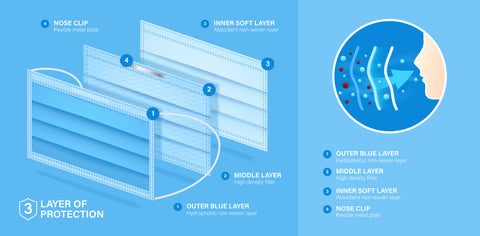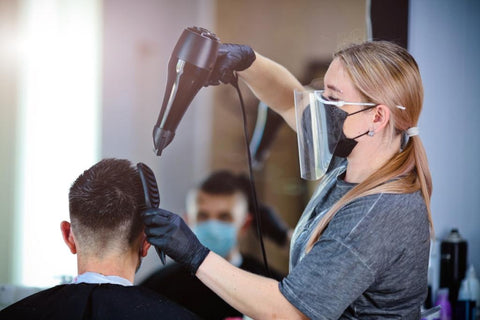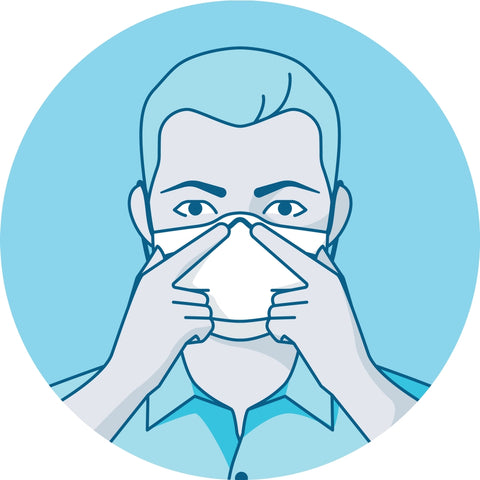The Definitive Face Mask Guide
How to choose between the Different Types of Face Masks
As the world moves further along the Coronavirus curve, everyone is eager to find effective ways at protecting themselves and others around them, particularly their families.
We’ve been reminded time and time again by public health authorities and public service messages advertised across a variety of channels – that staying at home time is the best option to deal with pandemics – and it’s safe to say that most of us have probably reduced our outdoors time by now to a great extent.
However, at some point, we will find ourselves stepping outdoors and coming into contact with other people in a variety of settings: superstores, banks, malls, a sidewalk or perhaps a friend’s place.
This is why we’ve prepared a definitive guide through which you can quickly understand what kind of face masks are currently available on the US market, what their uses are, and which ones are right for your individual application.
Let’s talk about the different types of Face Masks available
Health organizations, bodies and experts strongly recommend some of kind of face mask or face covering in order to stay safe from airborne viruses like COVID-19 and other health hazards. Many different kinds of masks are available today, ranging from respirators and surgical masks to homemade face coverings.
According to the CDC and WHO, basic surgical masks have been approved for public use – the thin-layered masks typically available in green which are designed to help you prevent spreading any illnesses to others.
However, these are not the only options currently available on the face mask market, with many consumers exploring a variety of options to meet their protection needs:
- Surgical face mask
- Basic cloth-based face covering
- N95 respirator
- KN95 respirator
- Gas mask/P100 respirator
- Filtering facepiece respirator
- Full face respirator
- Full-length face shield
- Self-contained respiratory apparatus
Surgical face mask
FDA-approved, surgical masks are made using a thin, disposable material. However, medical professionals who are carrying out drive-thru COVID-19 testing can be seen wearing many versions of surgical face masks, including those that cover their eyes, cheeks and forehead as well. Doctors and respiratory therapists typically wear surgical/medical masks.
Protection standard
Surgical masks are affixed to the head with straps and have been tested according to a variety of test methods such as EN 14683, ASTM F2100 or equivalent. They balance high filtration with good breathability while optionally offering fluid contamination resistance as well.
When to use
Surgical or medical masks are typically meant for healthcare workers only. The fluid resistance provides the wearer protection against large splashes, droplets or sprays of bodily fluids or other health-threatening fluids. Furthermore, they protect the patient from the wearer’s breathing (carbon dioxide) emissions, which may or may not potentially be infected with Coronavirus.
Respirators
N95
You’ll rarely if ever see any N95 respirators being used by the general public as they are considered ‘critical safety equipment’ meant only for medical first responders and healthcare workers. We’d strongly recommend not buying or using them, unless your day-to-day job requires working with patients. Supplies of N95 respirators are typically scarce and we should do our part in assuring that they are available to healthcare professionals when needed.
KN95
KN95s are quite similar to N95s: both are capable of capturing at least 95% of tiny airborne particles – however the key difference is that the latter can capture significantly larger particles.
P100
These are not typically associated with healthcare or worn by those in a medical setting at all. They are, instead, worn by woodworkers and painters, or other professionals who come into regular contact with asbestos, lead and other chemicals. There’s no need to wear this kind of face mask to prevent the spread of Coronavirus.
Filtering Facepiece type
Like surgical/medical face masks, this type of face mask is disposable. It isn’t very commonly used to prevent airborne illnesses from spreading, but rather used to cut down exposure to certain particles which hover in the air due to pollen, animal dander and wood dust. If you’re suffering from allergies, this mask may offer some level of protection during the COVID-19 pandemic.

Full face respirator
Some of us may have a hard time breathing in a surgical or cloth mask. In that case, a full face respirator can come in handy, although it is typically worn while working on home improvement projects. With that said, this type of mask is usually reserved for people who are already suffering from respiratory problems.
Protection standard
All respirators including filtering facepiece respirators (FFRs) have been tested, evaluated and approved by NIOSH (National Institute for Occupational Safety and Health) according to the desired requirements.
Respirators carrying the “FFP2/3” label have been designed to fit snugly around the face, providing a good level of filtration and protection against airborne particles, germs and viruses. All respirators carrying the FFP label are meant to be used in healthcare settings.
When to use
These are meant strictly for healthcare workers, doctors and nurses, and capable of filtering out minimum 95% of both small and large airborne particles. When fitted and donned properly around the face, chances of leakage around the edges are minimal upon inhaling.
Face Coverings
Full length face shield
If you’ve ever gotten a good look at the glass shields used by welders, then these are a plastic and somewhat flimsy version of more or less the same apparatus. It covers your entire face from forehead to chin and comes with a cushioned headband to keep it secured in place. It isn’t an ideal way to protect against COVID-19 and can be tough to breathe in the longer you keep it on.
Self-contained respiratory apparatus
You’ll see firefigthers wear these as it allows them to breathe clean air in dangerous and volatile situations where explosions can easily occur due to too much gas. There’s absolutely no need to consider wearing this type of mask for protecting against COVID-19 – especially since they are purpose built for firefighters and rescue workers.
Protection standard
Face shields are governed by ANSI Z87.1-2015 standards while self-contained breathing apparatuses (SCBAs) fall under the NFPA 1500 respiratory protection program.
When to use
Never! These are not meant for COVID-19 and exclusively reserved for rescue workers and firefighters.
Cloth-based face coverings
Basic cloth face mask
This is what we call your ‘everyday’ face mask. It’s also what the CDC highly recommends for protection against COVID-19. These types of masks can be conveniently worn when going to open public places like gas stations, grocery stores, malls, parks, etc.
Face mask with filters
When it comes to face masks for the general public for protection against COVID-19, perhaps the best, most cost-effective option at the moment is a fitted face mask with a filter. Filters that have an efficiency of over 85% offer good levels of protection and when combined with a fitted mask that minimizes leakage, protection levels increase.
Leakage can be reduced even further with the addition of a nose bridge, similar to the ones used on face masks with the FFP designation. Good levels of protection are offered against all kinds of airborne germs and viruses. These types of face masks are often easier to breathe in and can be worn comfortably for longer periods of time.
Protection standard
Face masks with filters provide a higher level of protection than basic cloth face masks or cloth face coverings. Exact standards for each are not established yet as they are meant for the general public and not health professionals.
When to use
The Center for Disease and Control (CDC) recommends that the general public cover their faces with a face covering when out in public, as it ensures that people who may be carrying unknowingly Coronavirus do not transfer it to others.
A good-quality mask should have filtration, multiple layers of high-quality fabric and fit snugly but comfortably around your face. Most high-quality face coverings offer great breathability and can be washed multiple times to wear again and have the same level of protection. Breathing is unrestricted and as you never feel claustrophobic due to inhaling your own respiratory emissions.
Face masks can also be laundered effectively without damaging the shape or material, and used just as effectively multiple times.
So which one should I choose at the end of the day?

Face coverings
- Offer a good level of protection through multiple fabric layers
- Well-suited to non-clinical settings and meant to be worn by the general public only
- Can be washed and used again
Fitted face coverings with filters
- The fitted design reduces leakage and offers a better level of protection
- A nose bridge reduces leakage further
- Filters combined with multiple fabric layers make breathing easier and increase protection
- Well-suited to non-clinical settings, closed spaces and meant to be worn by the general public
- Are comfortable to wear for longer periods of time
- Can be washed and used again
Face mask
- A loose-fitting disposable mask classified according to Type I, II or IIR
- Prevents the user’s respiratory emissions from contaminating surfaces and other people
- Fluid splash resistant types protect against large droplets, splashes or sprays of bodily fluids
- Currently used in healthcare, industry and even community settings like public transport, stores, shopping centers, etc.
Respirators
- A snugly fitting protective mask offering more efficient protection against airborne particles
- Classified as FFP1, FFP2 or FFP3 according to the level of protection required
- Offers the wear protection against inhaling hazardous airborne particles including viruses, small particle aerosols and droplets
- Good for protection when aerosol generating procedures are being carried out on a COVID-19 patient
- Not recommended for the general public and strictly reserved for healthcare workers
Closing thoughts
The CDC recommends face coverings for the majority of people who simply need protection in an ‘open public’ setting.
For optimal protection and comfort, a fitted face covering with a high efficiency filter is all the protection you need, really.



